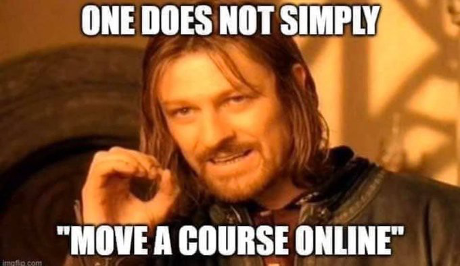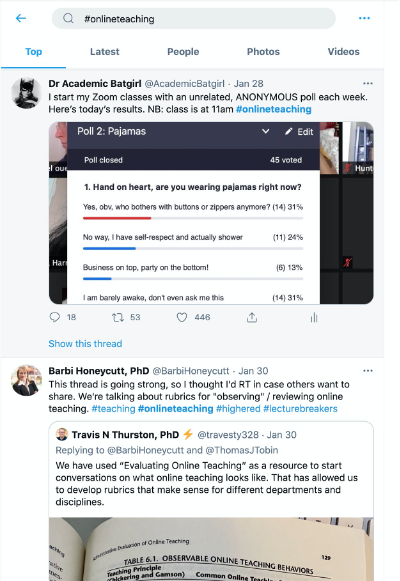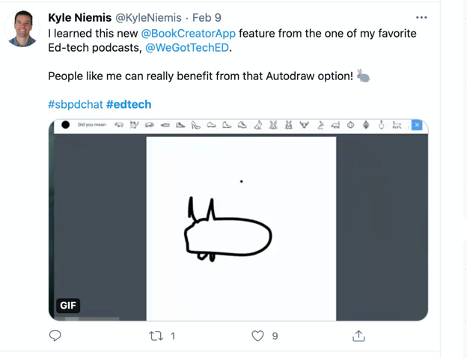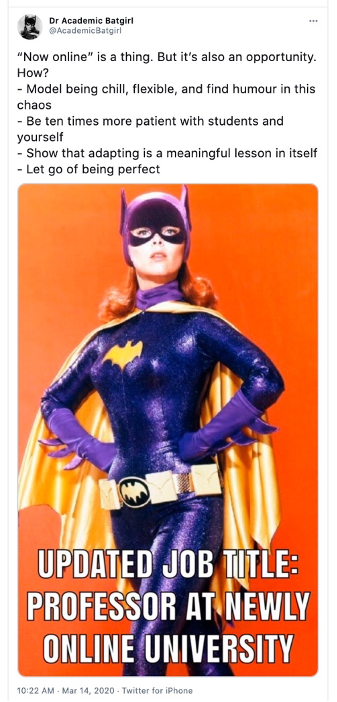Using Media to Teach Media: How the Scholarship of Teaching and Learning Slayed the Online Scene
Sharon Lauricella / Ontario Tech University

In the “before times,” classroom sounds included the snap and fizz of soda cans, students greeting one another with hand slaps and side hugs, and the shuffle of winter boots or hopeful springtime flip-flops. Now, the preamble to class is a playlist I made on Spotify, funny avatars on Zoom, and a lively flurry of silent but enthusiastic “good morning!” greetings in the chat. The in-class activity has shifted from f2f to the digital realm, but how do instructors even learn how to facilitate this? Now that we are shifting from “emergency remote teaching” to legit “online teaching and learning,” how do we get—and stay—on top of this ever-changing landscape?
When the pandemic shuttered f2f classrooms and opened Zoom rooms, campus Teaching and Learning centers scrambled to send helpful resources or guides for best online teaching practices. However, emailed instructions and remote consultations arguably weren’t where it was at for instructors of communication and digital media. Most of us already used Zoom or at very least had social media accounts. But we were still faced with an unprecedented challenge: within days, all undergraduate courses needed to be shifted to online delivery due to isolation requirements of the COVID-19 pandemic. The design, plan, and rollout of an online course can take months, if not years, and we needed answers. And we needed them… now.

I argue that the real hero of the shift to online teaching was social media. There simply wasn’t time—no matter our level of comfort with technology—to dither around and find the perfect tools for the nauseatingly-termed “pivot” to online/remote/emergency teaching. The issues at stake weren’t just practical tasks such as how to adjust our profile pictures in GoogleMeet or Zoom: they were deeper pedagogical queries such as how to deal with grades when assignments had to be revamped (Morris, 2020) and how to embody trauma-informed teaching (Carello, 2020). Should we all read published monographs on educational technology? Ain’t nobody got time for that in March, 2020. We could wade through journal articles on best practices? Still nah, too much chasing around. Most scholars had just a weekend to turn everything literally inside out and backwards.
And that’s why we needed social media. This online venue offers immediate answers, and even the likelihood of immediate interaction. The contemporary nature of online posts, hashtag searches, and presence of trusted advisors won the day. More specifically, Twitter is where the #AcademicTwitter fam hangs out. While Insta-baddies have had their time and Facebook has newfound vacancies, Twitter is the place where all things academic come to work and play.
When we all retreated to our makeshift desks at home, the #AcademicTwitter community rallied together to share #EdTech tips and suggestions for #onlineteaching. Through the use of hashtags, promotion of helpful advice, and online Q&A sessions in the form of Tweet chats, higher education instructors were able to engage immediately and get timely advice on how to shift online in 2020. Further, we’ve learned how to stay online in 2021.

For example, a search for #onlineteaching brings up top (i.e., the most “liked” or retweeted) posts, the latest (or most recent) ones, and the top people tweeting about #onlineteaching. A hashtag search brings up popular accounts to follow, relevant tweets, and even threads on any hashtagged topic anyone feels like searching. Want to know more about educational technologies? Search for #edtech and find suggestions from #edtech leaders, learn about new apps suitable for teaching at any level and topic, or see examples of #edtech in action.

One of the more contemporary uses of Twitter is the use of threads, which offered notable assistance at the start and throughout the COVID-19 pandemic. A thread is constructed when a user posts a series of linked, serialized tweets on a specific topic or to tell a story. When the pandemic forced us to flee campus, tweet threads covered descriptions of panic, frustrations, and general academic anxiety. But arguably there were just as many #AcademicTwitter heroes who responded with advice and support. For example, @flowerdarby, an educational designer, had recently published Small Teaching Online (Darby & Lang, 2019), and was quick to offer advice for making small but meaningful changes to take courses online. As @AcademicBatgirl, I also responded with encouragement for faculty wanting to connect with students, and offered advice on modeling flexibility, patience, and adaptation to a new environment.

Further, tweet chats became an increasingly popular method of support and communication throughout the pandemic. While most users tweet without expectation of immediate response or discussion, and are thus asynchronous, tweet chats occur when users posting about a specific topic join the Twitterverse for a scheduled, synchronous conversation, usually for an hour. Many such tweet chats had roots before the pandemic, but gained popularity as life moved increasingly online. For example, the #edtechchat hashtag had been around since 2013, but its scheduled Monday 8PM EST time slot gained traction during the pandemic.
It is important to note the difference between using social media for teaching and using social media to learn about teaching. Examples of using social media or technology in teaching, many of which are addressed in this forum, include Discord, podcasts, Telegram, and even oldies but goodies such as YouTube. Such tools may not have been designed for education but have found a home in our classrooms. However, it is essential to recognize that technology can be used to learn about teaching and pedagogy – not just as a teaching tool. Instructors are constantly urged to adopt technologies in and out of the classroom, but I suggest that an examination of how we find out how to use these tools is just as important to recognize.
As media scholars, we have a responsibility (read: obligation) to incorporate media into our teaching. We need to walk the talk of doing media rather than simply talking about it. To that end, I argue that recognizing how faculty have utilized social media and online technologies to find support, tips, instructions, and ideas is essential. Doing so demonstrates that faculty model for students qualities such as resourcefulness, currency, and creativity. It is simply not enough to boast about using a new tool or app. It is good and right to be transparent about how and why we as faculty learn and grow.
University and college faculty, as producers, consumers, and instructors of media, have increasingly consulted social media as a means of professional development. In particular, Twitter came to the rescue for many instructors throughout this [gestures wildly] pandemic. However, unlike emails with tips about changing an avatar or how to expense a Zoom account to a professional development fund, scholars sought one another on social media and found the right place to connect. Twitter has hosted a space for higher ed instructors to share best practices and make connections, and is firmly established as a go-to venue for teaching information. Instructors, while active consumers and producers of social media, ensure that we not only stay online but also define what “contemporary media” means.
Image Credits:
- The Lord of the Rings: The Fellowship of the Ring (Jackson, 2001) Meme
- Magikarp Guy meme, 2015. Learn more about the meme’s history here.
- Author screenshot of Twitter’s #onlineteaching hashtag.
- Author screenshot of Twitter’s #edtech hashtag.
- Screenshot Tweet from author’s account, @AcademicBatgirl.
Carello, J. (2020, April 6). Trauma-informed teaching and learning in times of crisis. [YouTube video]. Retrieved from https://www.youtube.com/watch?v=AuRxxPK9Hyc&feature=youtu.be
Darby, F. & Lang, J. (2019). Small Teaching Online. San Francisco, CA: Wiley.
Morris, S. M. (2020, December 9). Critical digital pedagogy after COVID-19. [Blog post]. Retrieved from https://www.seanmichaelmorris.com/critical-digital-pedagogy-after-covid-19/
If you are a student and are reading this commentary, then i recommend that you buy homework from the site that provides not only homework on stem disciplines but also homework on humanities.
ahahahah, +++++